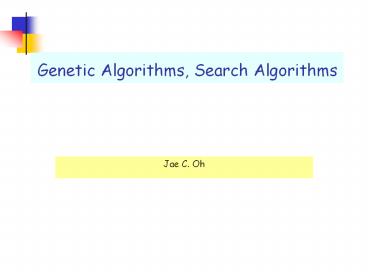Genetic Algorithms, Search Algorithms - PowerPoint PPT Presentation
1 / 28
Title:
Genetic Algorithms, Search Algorithms
Description:
The lesser the value, the fitter the solution is. Producing Offspring ... Strings that are fitter are assigned a larger slot and hence have a better ... – PowerPoint PPT presentation
Number of Views:189
Avg rating:3.0/5.0
Title: Genetic Algorithms, Search Algorithms
1
Genetic Algorithms, Search Algorithms
- Jae C. Oh
2
Overview
- Search Algorithms
- Learning Algorithms
- GA
- Example
3
Brief History
- Evolutionary Programming
- Fogel in 1960s
- Individuals are encoded to be finite state
machines - Intellgent Behavior
- Evolutionary Strategies
- Rechenberg, Schwefel in 1960s
- Real-valued parameter optmization
- Genetic Algorithms
- Holland in 1960s
- Adaptive Systems
- Crossover Operators
4
Current Status
- Wide variety of evolutionary algorithms
- No one seriously tries to distinguish them except
for some cases and purposes. - We will call all Evolutionary Algorithms
- And I will call them Genetic Algorithms or
Evolutionary Algorithms for generic terms
5
Search
6
Search
7
Search
8
Notion of Search Space
- Real world problem
- Search space
- Abstraction -gt State Space
- Exploring the state space for given problem ?
Search Algorithms
The Peak
Search Space
9
Learning Algorithms
- Finding (through search) a suitable program,
algorithm, function for a given problem
Learning Algorithm
Training Data (Experience)
Program
10
Learning Algorithms (function Optimizations)
Problem instance
Set of Hypothesis
The One??
Hypothesis Space Program Space Function Space
11
Learning Algorithms (Digression)
- How do we know the found hypothesis, program,
function, etc. are the one we are looking for? - We dont know for sure
- Is there any mathematical way of telling how good
hypothesis is? - I.e., h(x) f(x) ?
- Computational Learning Theory can tell us this
- Valiant (1984)
12
What are Genetic Algorithms?
- Find solutions for a problem with the idea of
evolution. Search and optimization techniques
based on Darwins Principle of Natural Selection. - Randomized search and optimization algorithms
guided by the principle of Darwins natural
selection Survival of fittest. - Evolve potential solutions
- Step-wise refinement?
- Mutations? Randomized, parallel search
- Models natural selection
- Population based
- Uses fitness to guide search
13
Evolution is a search process
From the Tree of the Life Website,University of
Arizona
Orangutan
Human
Gorilla
Chimpanzee
14
Evolution is parallel search
15
Genetic Algorithm Overview
- Starting with a subset of n randomly chosen
solutions ( )from the search space (i.e.
chromosomes). This is the population - This population is used to produce a next
generation of individuals by reproduction - Individuals with a higher fitness ( - )have
more chance to reproduce (i.e. natural selection)
16
GA in Pseudo code
0 START Create random population of n
chromosomes 1 FITNESS Evaluate fitness f(x) of
each chromosome in the population 2 NEW
POPULATION 0 SELECTION Based on f(x) 1
RECOMBINATION Cross-over chromosomes 2
MUTATION Mutate chromosomes 3
ACCEPTATION Reject or accept new one 3
REPLACE Replace old with new population the
new generation 4 TEST Test problem
criterium 5 LOOP Continue step 1 4 until
criterium is satisfied
17
GA vs. Specialized Alg.
Genetic Algorithms (GAs)
GA
Efficiency
Specialized Algo.
Problems
P
Specialized algorithms best performance for
special problems Genetic algorithms good
performance over a wide range of problems
18
Randomized Algorithms
- Guided random search technique
- Uses the payoff function to guide search
Hill Climbing
local optima
Global optima
19
Evolutionary Algorithms?
- Search Algorithms?
- Learning Algorithms?
- Function Optimization Algorithms?
They are fundamentally the same!!
20
Things needed for GAs
- How do we represent individuals? Domain Dependent
- How do we interpret individuals?Domain Dependent
- What is the fitness function?Domain Dependent
- How are individual chosen for reproduction?Choose
better individuals (probabilistic) - How do individuals reproduce?Crossover,
Mutation, etc. - How is the next generation generated?Replace
badly performing individuals
21
Encoding Methods
Binary Encoding/Ternary Encoding
Permutation Encoding (TSP)
Real numbers, etc. Specialized
22
Fitness Function
- A fitness function quantifies the optimality of a
solution (chromosome) so that that particular
solution may be ranked against all the other
solutions. - A fitness value is assigned to each solution
depending on how close it actually is to solving
the problem. - Ideal fitness function correlates closely to
goal quickly computable. - Example. In TSP, f(x) is sum of distances between
the cities in solution. The lesser the value, the
fitter the solution is
23
Producing Offspring
- The process that determines which solutions are
to be preserved and allowed to reproduce and
which ones deserve to die out. - The primary objective of the recombination
operator is to emphasize the good solutions and
eliminate the bad solutions in a population,
while keeping the population size constant. - Selects The Best, Discards The Rest.
24
Roulette Wheel Selection
Chromosome Fitness 1 15.3089 2 15.4091
3 4.8363 4 12.3975
4
3
1
2
Spin
Strings that are fitter are assigned a larger
slot and hence have a better chance of appearing
in the new population.
25
GA in Action for 8-Queen
26
Fitness for 8-Queen?
Minimum conflict fitness function.
27
Theory (Schema Theorem)
- Schema
- Substring where some positions left undecided
- 246
- Instance of this schema 24613587
- Theorem if the average of the instances the
schema is above the mean fitness of the
population, the number of instances of the schema
will increase over time.
28
Applications
- Many many
- VLSI, TSP, Function Optimization, Data mining,
security, etc.































